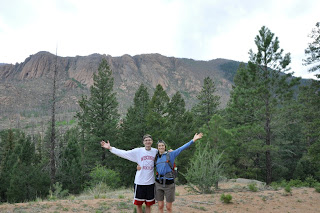This
challenge was started almost a week ago on a Saturday morning when I unpacked my Mediterranean cookbook. I opened it and was immediately entranced by the pictures it contained, including
Involtini of Swordfish and
Higas Rellenos. Suddenly,
the notion to cook my way through the countries within it enticed my interest. Turning to Joe (who was preoccupied by a
youtube ski video), I opened the pages to the table of contents and asked him to pick a country that he would like me to cook through this summer. Without thought, he pointed at Italy.
Sounds good to me! Italy it is!
 |
The Essential Mediterranean Cookbookby Juliet Rogers, Copyright 2005
ISBN 1-74045-776-5 |
 |
| Given to me by my wonderful parents. I love them! |
 |
Sample of the text. The picture of the bottom right
shows the Baked Peppers that I forgot to document with my own camera. |
Visiting Italy six years ago was my first exposure to European culture. I remember thinking that the smells, people, vegetation and foods were about as colorful as anything I'd ever experienced. I remember thinking I should drop out of college, find a job a random vineyard in the hills of Tuscany, and grow old drinking Chianti and sampling pungent cheeses... oh, the glorious dreams I had! The fact that Joe picked Italy meant I could travel back and retrace fond memories. It was also a good pick because it is the season of summer. Italian cuisine fits perfectly due to simplistic recipes with an emphasis on fresh ingredients.
I chose to start with two recipes:
Baked Peppers with Anchovies (page 89) and
Spaghetti Puttanesca (page 110). From here on I will reference the page numbers within the cookbook where the complete recipes can be found. Instead of filling space with the recipes themselves (that can sometimes be very extensive), I want to elaborate on details that personalize the recipes, such as cooking methods, kitchen experiences, ingredient descriptions, and so on.
My ingredients for these recipes sat idle for three full days as new activities and social events kept arising that competed with our first Italian dinner at home. Last Monday, I was determined that we could manage both: an early evening on a "peddle hopper" with Joe's fellow interns and a retreat back to our apartment for a late meal of peppers and puttanesca (mostly because I was getting growing concern over the lifespan of my capsicum peppers)! To make this work, I decided to assemble the peppers and prepare the sauce for the pasta early afternoon. That way when we returned home around 8 pm, all I would have to do would be to cook the pasta and bake the peppers while letting the sauce simmer a bit longer. As the night progressed, our fine Italian dinner was substituted for one too many beers (never underestimate a bunch of medical residents about to kiss their summer freedoms goodbye while dressed in funny costumes on a peddle bus...)! We put the food in the refrigerator before retiring for the night.
Late the following morning I was expecting to find pruned, soggy peppers that would have to be tossed. To my dismay, they were just as beautiful as when I had left them the afternoon before! Well, this called for a lavish brunch of Italian fare to cure our sorry selves. I immediately began to preheat the oven and put the final garnishes on the peppers, such as the slivered anchovies and torn basil leaves, as well as put the sauce on the stove to a slow simmer. By 12:30 pm the stove was off and the food was warm.
I regret that I didn't think to take any pictures of the peppers but they were wonderfully caramelized on the bottom with a soft belly that kicked your taste buds with a harmony of salty anchovies and fresh basil. The pasta was also dressed in distinctly Italian flare with the combination of flavors such as Kalamatas, capers, anchovies, fresh parsley and a lingering heat from a few pinches of chili flakes. I quickly discovered that Joe was not thrilled with the olives as they slowly grew into a pile at the edge of his plate (his loss, my gain)!
There are some dishes that are known to be better the next day. I think this Puttanesca sauce is one of them, being that the individual ingredient flavors grew more pronounced during their long slumber in the fridge. I am also happy to note that these recipes can hold up to preparation a day in advance. This may come in handy for future time crunches and convenience. The leftovers of each of these recipes were excellent to the third day (the pasta did soften with time).
 |
A visual sampling of my first pasta (minus the olives since this was Joe's dish).
Parmesan was added to this dish for a hearty twist for
for lunch, but is not called for in the original recipe. |
A bit of fun trivia:
Puttanesca comes from the Italian word for whore (
puttana). As one can imagine, there are many stories surrounding this dish. Does it stem from the intense flavors of the sauce that charmed men who would eat of it, or did it originate from women who were forbidden to shop for groceries during regular hours and survived on pantry staples (olives, anchovies, etc.)?

